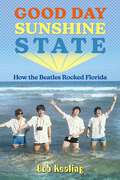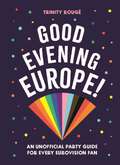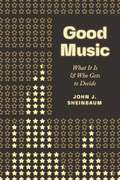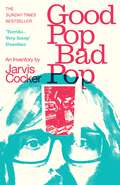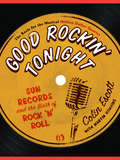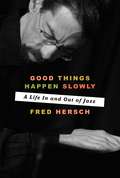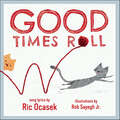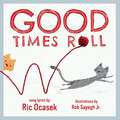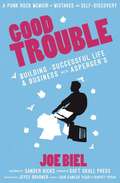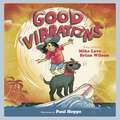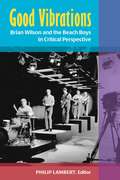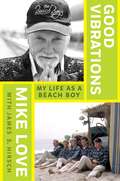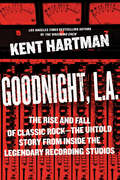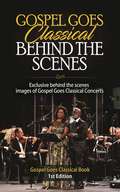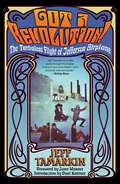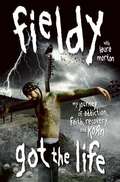- Table View
- List View
Good Day Sunshine State: How the Beatles Rocked Florida (Co-published with Florida Humanities)
by Bob KealingThe musical and cultural impact of the Fab Four in Florida In 1964, Beatlemania flooded the United States. The Beatles appeared live on the Ed Sullivan Show and embarked on their first tour of North America—and they spent more time in Florida than anywhere else. Good Day Sunshine State dives into this momentous time and place, exploring the band’s seismic influence on the people and culture of the state. Bob Kealing sets the historical stage for the band’s arrival—a nation dazed after the assassination of John F. Kennedy and on the precipice of the Vietnam War; a heavily segregated, conservative South; and in Florida, recent events that included the Cuban Missile Crisis and the arrest and imprisonment of Martin Luther King Jr. in St. Augustine. Kealing documents the culture clashes and unexpected affinities that emerged as the British rockers drew crowds, grew from fluff story to the subject of continual news coverage, and basked in the devotion of a young and idealistic generation. Through an abundance of letters, memorabilia, and interviews with journalists, fellow musicians, and fans, Kealing takes readers behind the scenes into the Beatles’ time in locations such as Miami Beach, where they wrote new songs and met Muhammad Ali. In the tropical environs of Key West, John Lennon and Paul McCartney experienced milestone moments in their friendship. And the band dodged the path of Hurricane Dora to play at the Gator Bowl in Jacksonville, where they famously refused to perform until the city agreed to integrate the audience. Kealing highlights the hopeful futures that the Beatles helped inspire, including stories of iconic rock-and-rollers such as Tom Petty who followed the band’s lead in their own paths to stardom. This book offers a close look at an important part of the musical and cultural revolution that helped make the Fab Four a worldwide phenomenon.Funding for this publication was provided through a grant from Florida Humanities with funds from the National Endowment for the Humanities. Any views, findings, conclusions or recommendations expressed in this publication do not necessarily represent those of Florida Humanities or the National Endowment for the Humanities.
Good Evening Europe!: An unofficial party guide for every Eurovision fan
by Pyramid Trinity RougéFrom the good, the bad and the downright extraordinary, the Eurovision Song Contest is more than just one night of the year, it's a celebration of all things fabulous. This handy little guide is jam-packed with a myriad of Eurovision ideas to help you get your party started and guarantee yourself a great celebration that's as weird and wonderful as the acts themselves.So, get ready for questionable outfits, hilarious sassy commentary and lots of feathers.This isn't the time to be formal or trendy - focus on flamboyance and tackiness in large doses. Lay on the cheese as thickly as you can, and you won't go far wrong!
Good Evening Europe!: An unofficial party guide for every Eurovision fan
by Pyramid Trinity RougéFrom the good, the bad and the downright extraordinary, the Eurovision Song Contest is more than just one night of the year, it's a celebration of all things fabulous. This handy little guide is jam-packed with a myriad of Eurovision ideas to help you get your party started and guarantee yourself a great celebration that's as weird and wonderful as the acts themselves.So, get ready for questionable outfits, hilarious sassy commentary and lots of feathers.This isn't the time to be formal or trendy - focus on flamboyance and tackiness in large doses. Lay on the cheese as thickly as you can, and you won't go far wrong!
Good Morning Blues: The Autobiography of Count Basie
by Count BasieCount Basie was one of America&’s pre-eminent and influential jazz pianists, bandleaders, and composers, known for such classics as &“Jumpin&’ at the Woodside,&” &“Goin&’ to Chicago Blues,&” &“Sent for You Yesterday and Here You Come Today,&” and &“One O&’Clock Jump.&” In Good Morning Blues, Basie recounts his life story to Albert Murray, from his childhood years playing ragtime with his own pickup band at dances and pig roasts, to his years in New York City in search of opportunity, to rollicking anecdotes of Basie&’s encounters with Fats Waller, Frank Sinatra, Fred Astaire, Sammy Davis Jr., Quincy Jones, Billie Holliday, and Tony Bennett. In this classic of jazz autobiography that was ten years in the making, Albert Murray brings the voice of Count Basie to the printed page in what is both testimony and tribute to an incredibly rich life.
Good Music: What It Is & Who Gets to Decide
by John J. SheinbaumOver the past two centuries Western culture has largely valorized a particular kind of “good” music—highly serious, wondrously deep, stylistically authentic, heroically created, and strikingly original—and, at the same time, has marginalized music that does not live up to those ideals. In Good Music, John J. Sheinbaum explores these traditional models for valuing music. By engaging examples such as Handel oratorios, Beethoven and Mahler symphonies, jazz improvisations, Bruce Springsteen, and prog rock, he argues that metaphors of perfection do justice to neither the perceived strengths nor the assumed weaknesses of the music in question. Instead, he proposes an alternative model of appreciation where abstract notions of virtue need not dictate our understanding. Good music can, with pride, be playful rather than serious, diverse rather than unified, engaging to both body and mind, in dialogue with manifold styles and genres, and collaborative to the core. We can widen the scope of what music we value and reconsider the conventional rituals surrounding it, while retaining the joys of making music, listening closely, and caring passionately.
Good Pop, Bad Pop: The Sunday Times bestselling hit from Jarvis Cocker
by Jarvis CockerThe Sunday Times bestselling hit memoir from Pulp frontman Jarvis Cocker.'It's real gold... its storytelling first class' Sunday TimesWhat if the things we keep hidden say more about us than those we put on display?We all have a random collection of the things that made us - photos, tickets, clothes, souvenirs, stuffed in a box, packed in a suitcase, crammed into a drawer. When Jarvis Cocker starts clearing out his loft, he finds a jumble of objects that catalogue his story and ask him some awkward questions:Who do you think you are?Are clothes important?Why are there so many pairs of broken glasses up here?From a Gold Star polycotton shirt to a pack of Wrigley's Extra, from his teenage attempts to write songs to the Sexy Laughs Fantastic Dirty Joke Book, this is the hard evidence of Jarvis's unique life, Pulp, 20th century pop culture, the good times and the mistakes he'd rather forget.This is not a life story. It's a loft story.'Nostalgic, playful and beautifully designed' Daily Mail'Brilliant...lurid, entertaining' Daily Telegraph'Terrific... Very funny' Guardian* A Book of the Year in the Daily Telegraph, Financial Times, Daily Mail and Uncut *
Good Rockin' Tonight
by Colin Escott Martin HawkinsRock 'n' roll was born in Memphis in the tiny storefront recording studio of Sun Records. <P><P>This is the definitive account of how it happened! Sam Phillips's credo was: "If you're not doing something different, you're not doing anything." <P> If he had done no more than discover Elvis Presley and produce his first five singles he would still be the godfather of rock 'n' roll. But he did more. <P>Much more. While Elvis was still sitting on the edge of his bed listening to the radio and figuring out guitar chords, Phillips was discovering and recording blues giants like B.B. King, Howling Wolf, and Ike Turner. <P>During the few months that Elvis was with Sun Records, Phillips found Johnny Cash and Carl Perkins. Soon after, he found Jerry Lee Lewis, Roy Orbison, and Charlie Rich. <P>And he did it almost singlehandedly--from his two-room studio in Memphis, Tennessee. <P> Phillips's story, which Colin Escott tells in beautiful detail, is more than a catalog of hits. <P>Without Sun's philosophy of experimentation, innovation, and genre transcendence, the musical revolution could have never begun.
Good Rockin' Tonight: Sun Records and the Birth of Rock 'N' Roll
by Colin Escott Martin HawkinsMemphis, Tennessee. The early 1950s. The Mississippi rolls by, and there's a train in the night. Down on Beale Street there's hard-edged blues, on the outskirts of town they're pickin' hillbilly boogie.At Sam Phillips' Sun Records studio on Union Avenue, there's something different going on. "Shake it, baby, shake it!" "Go, cat, go!" "We're gonna rock..."This is where rock 'n' roll was born-the record company that launched Elvis Presley, Jerry Lee Lewis, Johnny Cash, Roy Orbison, and Carl Perkins. The label that brought the world, "Blue Suede Shoes," "Whole Lotta Shakin' Goin' On," "Breathless," "I Walk the Line," "Mystery Train," "Baby, Let's Play House,' "Good Rockin' Tonight." Good Rockin Tonight is the history, in words and over 240 photographs, of Sam Phillips' legendary storefront studio, from the early days with primal blues artists like Howlin' Wolf and B.B. King to the long nights in the studio with Elvis and Jerry Lee. As colorful and energetic as the music itself, it's a one-of-a-kind book for anyone who wants to know where it all started.
Good Things Happen Slowly: A Life In and Out of Jazz
by Fred HerschJazz could not contain Fred Hersch. Hersch’s prodigious talent as a sideman—a pianist who played with the giants of the twentieth century in the autumn of their careers, including Art Farmer and Joe Henderson—blossomed further in the eighties and beyond into a compositional genius that defied the boundaries of bop, sweeping in elements of pop, classical, and folk to create a wholly new music. <p><p> Good Things Happen Slowly is his memoir. It’s the story of the first openly gay, HIV-positive jazz player; a deep look into the cloistered jazz culture that made such a status both transgressive and groundbreaking; and a profound exploration of how Hersch’s two-month-long coma in 2007 led to his creating some of the finest, most direct, and most emotionally compelling music of his career. <p> Remarkable, and at times lyrical, Good Things Happen Slowly is an evocation of the twilight of Post-Stonewall New York, and a powerfully brave narrative of illness, recovery, music, creativity, and the glorious reward of finally becoming oneself.
Good Times Roll (LyricPop)
by Ric OcasekRic Ocasek’s rock and roll classic, “Good Times Roll”—one of the Cars’ greatest hit songs—leaps off the page in this exhilarating picture book.“Let the good times rollLet them knock you aroundLet the good times rollLet them make you a clown . . .”Good Times Roll is a delightful picture book based on the Cars’ hit rock and roll song written by lead singer/guitarist Ric Ocasek. “Good Times Roll” was the third single on the Cars’ groundbreaking debut 1978 album The Cars, which has sold over six million copies and peaked at #18 on the Billboard 200 albums chart.Artist Rob Sayegh Jr. perfectly captures the playful spirit of Ocasek’s song in this beautifully illustrated picture book. Any child (or adult) who’s ever spent time with a cat will appreciate how good the times roll for felines when chasing an unraveling ball of yarn. With energy and humor, Sayegh’s cat will charm parents and children alike, to the tune of one of rock and roll’s most memorable songs
Good Times Roll: A Children's Picture Book (LyricPop #0)
by Ric OcasekRic Ocasek's rock and roll classic, "Good Times Roll"—one of the Cars' hit songs—leaps off the page in this exhilarating picture book. "Let the good times roll Let them knock you around Let the good times ro
Good Trouble: Building a Successful Life and Business with Asperger's (Punx Ser.)
by Sander Hicks Joe Biel Joyce Brabner<p>In 1996, everything about Joe Biel's life seemed like a mistake. He was 18, he lived in Cleveland, he got drunk every day, and he had mystery health problems and weird social tics. <p>All his friends' lives were as bad or worse. To escape a nihilistic, apocalyptic worldview and to bring reading and documentation into a communal punk scene, he started assembling zines and bringing them in milk crates to underground punk shows. Eventually this became Microcosm Publishing. But Biel's head for math was stronger than his ability to relate to people, and it wasn't until he was diagnosed with Asperger's Syndrome that it all began to fall into place. <p>This is the story of how, over 20 years, one person turned a litany of continuing mistakes and seeming wrong turns into a happy, fulfilled life and a thriving publishing business that defies all odds.</p>
Good Vibrations (LyricPop)
by Brian Wilson Mike LoveMike Love and Brian Wilson’s world-famous song, gloriously illustrated by Paul Hoppe, will bring smiles to the faces of children and parents alike.“Zany fun . . . Good Vibrations is a good book for an aging Baby Boomer, a hipster, or a beach-going anyone.” —New York Journal of Books“I’m pickin’ up good vibrationsShe’s giving me the excitationsGood, good, good, good vibrationsShe’s giving me the excitations . . ."Good Vibrations is a lively picture book based on Mike Love and Brian Wilson’s number one hit about absorbing positive energy from the people around them. Often praised as one of the most important compositions in rock, the Beach Boys’ original version of this song was their third number one Billboard hit. With lyrics by Brian Wilson and Mike Love, and illustrations by Paul Hoppe, this picture book follows a girl and her dog as they make their way down to the beach, sharing good vibrations all along the way. Parents and children alike can share and enjoy one of rock’s greatest hits through the colorful pages of Good Vibrations.
Good Vibrations: A Children's Picture Book (LyricPop #0)
by Brian Wilson Mike LoveMike Love and Brian Wilson's world-famous song, gloriously illustrated by Paul Hoppe, will bring smiles to the faces of children and parents alike. I'm pickin' up good vibrations She's giving me the excitations (oom bop bop)
Good Vibrations: Brian Wilson and the Beach Boys in Critical Perspective
by Philip LambertGood Vibrations brings together scholars with a variety of expertise, from music to cultural studies to literature, to assess the full extent of the contributions to popular culture and popular music of one the most successful and influential pop bands of the twentieth century. The book covers the full fifty-year history of the Beach Boys' music, from essays on some of the group's best-known music--such as their hit single "Good Vibrations" --to their mythical unfinished masterpiece, Smile. Throughout, the book places special focus on the individual whose creative vision brought the whole enterprise to life, Brian Wilson, advancing our understanding of his gifts as a songwriter, arranger, and producer. The book joins a growing body of literature on the popular music of the 1960s, in general, and on Brian Wilson and the Beach Boys in particular. But Good Vibrations extends the investigation further and deeper than it has gone before, not only offering new understanding and insights into individual songs and albums, but also providing close examination of compositional techniques and reflections on the group's place in American popular culture.
Good Vibrations: My Life as a Beach Boy
by James S. Hirsch Mike Love<P>Mike Love tells the story of his legendary, raucous, and ultimately triumphant five-decade career as the front man of The Beach Boys, the most popular American band in history -- timed to coincide with the 50th anniversary of "Good Vibrations." The eBook edition includes 85 additional photos. <P>As a founding member of The Beach Boys, Mike Love has spent an extraordinary fifty-five years, and counting, as the group's lead singer and one of its principal lyricists. The Beach Boys, from their California roots to their international fame, are a unique American story -- one of overnight success and age-defying longevity; of musical genius and reckless self-destruction; of spirituality, betrayal, and forgiveness -- and Love is the only band member to be part of it each and every step. His own story has never been fully told, of how a sheet-metal apprentice became the quintessential front man for America's most successful rock band, singing in more than 5,600 concerts in 26 countries. <P>Love describes the stories behind his lyrics for pop classics such as "Good Vibrations," "California Girls," "Surfin' USA," and "Kokomo," while providing vivid portraits of the turbulent lives of his three gifted cousins, Brian, Dennis, and Carl Wilson. His partnership with Brian has few equals in American pop music, though Mike has carved out a legacy of his own -- he co-wrote the lyrics to eleven of the twelve original Beach Boy songs that were top 10 hits while providing the lead vocals on ten of them. <P>The band's unprecedented durability also provides a glimpse into America's changing cultural mores over the past half century, while Love himself has experienced both the diabolical and the divine -- from Charles Manson's "family" threatening his life to Maharishi instilling it with peace. A husband, a father, and an avid environmentalist, Love has written a book that is as rich and layered as the Beach Boy harmonies themselves. <P><b>A New York Times Bestseller</b>
Good night the pleasure was ours
by David GrubbsWith Good night the pleasure was ours, David Grubbs melts down and recasts three decades of playing music on tour into a book-length poem, bringing to a close the trilogy that includes Now that the audience is assembled and The Voice in the Headphones. In Good night the pleasure was ours, the world outside the tour filters in with eccentric sparseness. From teenage punk bands to ensembles without fixed membership, and from solo performance to a group augmented by digital avatars, Grubbs presents touring as a series of daily dislocations that provides an education distinctly its own. These musicians’ job is to play that evening’s gig—whether to enthusiastic, hostile, or apathetic audiences—and then to do it again the next day. And yet, over the course of the book’s multidecade arc, Grubbs depicts music making as an irreversible process—one reason for loving it so.
Goodbye 20th Century: A Biography of Sonic Youth
by David BrowneSonic Youth's distinctive, uncompromising sounds have provided a map for innumerable musicians who followed, from '90s groundbreakers like Nirvana and Pavement to current faves like the Strokes and the Yeah Yeah Yeahs. More than perhaps any other act, Sonic Youth has brought "fringe" art to the mainstream, helping spawn an alternative arts scene that prospers to this day: a world of punk rock, underground films and comics, experimental music, conceptual art, contemporary classical compositions, and even fashion. In Goodbye 20th Century, David Browne tells the full glorious story of "the Velvet Underground of their generation," an account based on extensive research, fresh interviews with the band and those who have worked with them (from Glenn Branca and Lydia Lunch to Sofia Coppola and Spike Jonze), and unprecedented access to unreleased recordings and documents. This is a richly detailed portrait of an iconic band and the times they helped create.
Goodbye Russia: Rachmaninoff in Exile
by Fiona MaddocksThe moving story of Rachmaninoff's years in exile and the composition of his last great work, set against a cataclysmic backdrop of two world wars and personal tragedy.In 1940, Sergei Rachmaninoff, living in exile in America, broke his creative silence and composed a swan song to his Russian homeland—his iconic &“Symphonic Dances.&” What happened in those final haunted years and how did he come to write his farewell masterpiece? Rachmaninoff left Petrograd (now St. Petersburg) in 1917 during the throes of the Russian Revolution. He was forty-four years old, at the peak of his powers as composer-conductor-performer, moving in elite Tsarist circles, as well as running the family estate, his refuge and solace. He had already written the music which, today, has made him one of the most popular composers of all time: the second and third Piano Concertos and two symphonies. The story of his years in exile in America and Switzerland has only been told in passing. Reeling from the trauma of a life in upheaval, he wrote almost no music and quickly had to reinvent himself as a fêted virtuoso pianist, building up untold wealth and meeting the stars—from Walt Disney and Charlie Chaplin to his Russian contemporaries and polar opposites, Prokofiev and Stravinsky. Yet the melancholy of leaving his homeland never lifted. Using a wide range of sources, including important newly translated texts, Fiona Maddocks&’s immensely readable book conjures impressions of this enigmatic figure, his friends and the world he encountered. It explores his life as an emigré artist and how he clung to an Old Russia which no longer existed. That forging of past and present meets in his Symphonic Dances (1940), his last composition, written on Long Island shortly before his death in Beverly Hills, surrounded by a close-knit circle of exiles. Goodbye Russia is a moving and prismatic look at Rachmaninoff and his iconic final work.
Goodnight, L.A.: The Rise and Fall of Classic Rock--The Untold Story from inside the Legendary Recording Studios
by Kent HartmanA behind-the-scenes journey through the rise and demise of the '70s and '80s classic rock eraBefore disco, punk, hair metal, rap, and eventually grunge took it all away, the music scene in Los Angeles was dominated by rock 'n' roll. If a group wanted to hit it big, L.A. was the place to be. But in addition to the bands themselves finding their footing, their albums also needed some guidance. That came from a group of dedicated producers and engineers working in a cadre of often dilapidated-looking buildings that contained some of the greatest recording studios the music industry has ever known.Within the windowless walls of these well-hidden studios, legends-to-be such as Foreigner, Fleetwood Mac, Pat Benatar, Boston, the Eagles, the Grateful Dead, Chicago, Linda Ronstadt, Santana, Tom Petty and the Heartbreakers, Loggins and Messina, REO Speedwagon, and dozens more secretly created their album masterpieces: Double Vision. Rumours. Hotel California. Terrapin Station. Damn the Torpedoes. Hi Infidelity. However, the truth of what went on during these recording sessions has always remained elusive. But not anymore.Longtime music-business insider Kent Hartman has filled Goodnight, L.A. with troves of never-before-told stories about the most prolific and important period and place in rock 'n' roll history. With music producer Keith Olsen and guitarist Waddy Wachtel as guides to the journey and informed by new, in-depth interviews with classic rock artists, famed record producers, and scores of others, Goodnight, L.A. reveals what went into the making of some of the best music of the past forty years. Readers will hear how some of their favorite albums and bands came to be, and ultimately how fame, fortune, excess, and a shift in listener demand brought it all tumbling down.
Gospel Goes Classical Behind the Scenes: Exclusive Behind the Scenes Images of Gospel Goes Classical Concerts. (Gospel Goes Classical Book 1st Edition #1)
by Steve LaneExclusive Behind the Scenes Images of Gospel Goes Classical Concerts.
Gospel Hymn Book: 795 Hymns
by John Ritchie Ltd.This is a non-denominational words-only collection of 795 hymns designated as "Gospel hymns." You'll find 33 hymns by the blind hymn writer Fanny J. Crosby, 39 hymns by the hymn writer Albert Midlane and 10 hymns of Charles Wesley. All hymns are produced in poetry style. The book is organized into 15 sections with hymns in each section in alphabetical order. Sections of the book include Adoration and Praise, Gospel, Entreaty and Warning, Testimony and Assurance, The Christian Life, Consecration, Prayer, The Scriptures, Resurrection of Christ, The Lord's Coming, and Heaven. The book closes with a complete alphabetical index of all hymns. Hymn titles have no punctuation but names and pronouns referring to God, Jesus, and the Holy Spirit are capitalized. If you keep this in mind, you should be able to search by name for a hymn you want to sing. With this collection on your paperless Braille device (including the free NLS eReader), you can lead or participate in a hymn sing. In the DAISY format, each section is at level 1 and each hymn is at level 2. As a result, Bookshare software will commence the BRF edition with a full table of contents followed by the text of the hymnal. For other hymn collections on Bookshare see also The United Methodist Hymnal, Glory to God (Presbyterian), Evangelical Lutheran Worship, and Lutheran Servicebook: Psalms and Hymns. For texts of cantatas by Johann Sebastian Bach, see The Church Cantatas of J. S. Bach by Alec Robinson (with commentary), and Johann Sebastian Bach: The Complete Cantatas in German-English translations by Richard Stokes.
Got Your Back: Protecting Tupac in the World of Gangsta Rap
by Heidi Cuda Frank AlexanderOn September 13, 1996, Tupac Shakur was shot and killed in Las Vegas. Millions of fans wept, while many critics claimed it was the inevitable result of a thugged-out lifestyle. The mystery surrounding the shooting-a suspect has yet to be named-has increased, and rumors of gang wars, disloyalty, and government conspiracies continue to linger. Only Frank Alexander, Tupac's bodyguard druing the last year of his life, knows the real story. Got Your Back details the exploits of one of the most famous rappers of all time. The drugs, the women, the violence, the money-all provided fuel to the fire that was Tupac's life. As his platinum-selling, posthumously released albums prove, Tupac lives on through his music. Complete with exclusive new interview material with Tupac's mother, Afeni, Got Your Back provides an insider's view of a life gone awry.
Got a Revolution!: The Turbulent Flight of Jefferson Airplane
by Jeff TamarkinThe most successful and influential rock band to emerge from San Francisco during the 1960s, Jefferson Airplane created the sound of a generation. Their smash hits "Somebody to Love" and "White Rabbit" virtually invented the era's signature pulsating psychedelic music and, during one of the most tumultuous times in American history, came to personify the decade's radical counterculture. In this groundbreaking biography of the band, veteran music writer and historian Jeff Tamarkin produces a portrait of the band like none that has come before it. Having worked closely with Jefferson Airplane for more than a decade, Tamarkin had unprecedented access to the band members, their families, friends, lovers, crew members, fellow musicians, cultural luminaries, even the highest-ranking politicians of the time. More than just a definitive history, Got a Revolution! is a rock legend unto itself. Jann Wenner, editor-in-chief and publisher of Rolling Stone, wrote, "The classic [Jefferson] Airplane lineup were both architects and messengers of a psychedelic age, a liberation of mind and body that profoundly changed American art, politics, and spirituality. It was a renaissance that could only have been born in San Francisco, and the Airplane, more than any other band in town, spread the good news nationwide."
Got the Life: My Journey of Addiction, Faith, Recovery, and Korn
by FieldyWhat have you got when you Got the Life? From Korn's legendary bassist comes a no-holds-barred look at the extreme highs and drug-and-booze-fueled lows of the biggest heavy metal band of our era Music was in his bones. From the time he was an infant, Fieldy watched his dad's band perform, and soon enough he found his own calling: the bass. After high school, with a guitar and little else, he left his small California town for the music scene in L.A. Before long, Fieldy, Brian "Head" Welch, James "Munky" Shaffer, drummer David Silveria, and Jonathan Davis would gel together and form a band with a completely new sound-Korn. What happened next was something Fieldy had always dreamed of but was totally unprepared for: Korn exploded, skyrocketing to the top of the charts and fronting the nu metal phenomenon. Fieldy was thrust into the fast-paced, hard-rocking spotlight. Korn began to tour incessantly, creating intense live shows fueled by wild offstage antics. Fieldy became a rock star, and he acted like one, notorious not only for his one-of-a-kind bass lines, but also for his hard-partying, womanizing, bad-boy ways. The more drugs he took, the more booze he drank, the worse he became: He was unfaithful, abusive, mean, and sometimes violent. By all appearances, Fieldy had the life. But he was on the dark path of excess, alienating friends, families, and loved ones, nearly destroying himself and the band. It took an unexpected tragedy to straighten him out: the death of his father, a born-again Christian, to a mysterious illness. Following his father's dying wish, Fieldy found God. Filled with the spirit of his new faith, Fieldy quit drugs and drinking cold turkey, and found the best part of himself. With never-before-seen photos, and never-before-heard stories, Got the Life is raw, candid, and inspiring-the ultimate story of rock and redemption.
